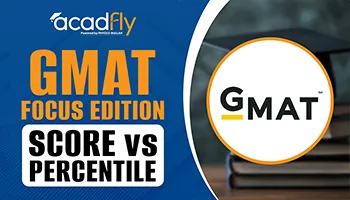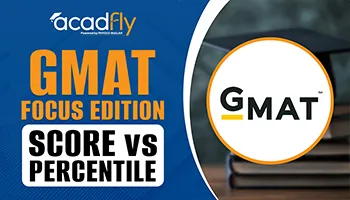

GMAT Focus Edition score vs. Percentile is the new trend now. Test takers need to understand this new format. Scores range from 205 to 805, increasing by 10 points. This score reflects how well one did on the shorter test. The smaller number is the percentile, which shows how one rank compares to others who took the test at the same time. For future MBA students, both the score and percentile matter because business schools look at both when selecting candidates. The GMAT 2025
What is the GMAT Focus Edition?
In 2023, the old GMAT was replaced by the GMAT Focus Edition. It is shorter and more overtly about business. The main changes are:
-
Shorter Test: Approximately 2 hours and 15 minutes, instead of more than 3 hours.
-
Fewer Sections: There are now three major sections:
-
Quantitative Reasoning: Problem-solving questions only (without Data Sufficiency).
-
Verbal Reasoning - Critical Reasoning, Reading Comprehension, but no Sentence Correction.
-
Data Insights: A new section that blends Integrated Reasoning and Data Sufficiency to gauge the skill at interpreting business data.
-
New Scoring Scale: Total scores are between 205 and 805 in 5-point increments, and section scores range from 60 to 90.
Understanding the GMAT Focus Edition Score
The score report has two types of scores. The system has changed, but it still measures the same skills, so it’s important to get familiar with it.
Composite Total Score (205-805)
This is the overall score that matters most to business schools. It’s based on how one did in Quantitative Reasoning, Verbal Reasoning, and Data Insights. All three sections now count equally toward this total score, making the Data Insights section more important for the final result.
Section Scores (60-90)
One’ll also get separate scores for each section—Quantitative Reasoning, Verbal Reasoning, and Data Insights—which show how well one performed in each area.
While a higher score is better, what is considered a "good" score can vary. Percentiles can help with this.The table below shows a better understanding of score calculation
The GMAT score is crucial. It helps one to stand out during competitive admissions, show readiness for the severities of business school, and open doors to more scholarships and funding.
Understanding GMAT Focus Edition Score |
|
|
Topic |
Details |
|
GMAT Focus Edition Total Score Range |
205 to 805, encompassing the combined scores from the three sections: Quantitative Reasoning, Verbal Reasoning, and Data Insights. |
|
Score Calculation |
Based on the number of correct answers, the difficulty of the questions, and other statistical properties. |
|
Sections Included |
Quantitative Reasoning, Verbal Reasoning, and Data Insights, each contributing to the overall score. |
|
Question Types |
Verbal: Critical Reasoning (Analysis/Critique and Construction/Plan) and Reading Comprehension (Identify Stated Idea and Identify Inferred Idea); Quantitative: Problem Solving, Algebra, and Arithmetic; Data Insights: Data Sufficiency, Graphs and Tables, Multi-Source Reasoning, and Two-Part Analysis |
|
Difference from Traditional GMAT |
Shorter has three sections instead of four, removes Geometry, Sentence Correction, and Analytical Writing Assessment (AWA), and has a new scoring system |
The Relevance of Percentiles
A percentile rank in the GMAT Focus Edition tells one how many test-takers scored below one. For example, if one scored at the 80th percentile, then one did better than 80% of all test-takers.
This is why percentiles are completely meaningful:
-
Relative Standing: The raw score is an absolute measure, but the percentile rank is relative. It puts the score into perspective among the whole group of GMAT test-takers.
-
Admissions Committee Insight: Indeed, AdComs don't look at the raw score by itself. They are provided with the percentile rank in order to see how competitive the score compares with their applicant pool and the general population of MBA candidates. The higher percentile means strong performance compared to the peers, which is a big plus.
-
Dynamic Character: Percentiles are dynamic. They are computed on the scores of all GMAT Focus Edition test-takers in the recent three-year time span. What this implies is that when the population of GMAT Focus Edition test-takers changes, so does the percentile for a given score. A score that ranked one at the 85th percentile in past years could rank one at the 83rd or 87th percentile this year, depending on how others have done.
Also Read: GMAT Sample Paper 2025, Ultimate Guide to Pass the Exam
How are the GMAT Focus Edition Percentile and Score related
GMAT Focus Edition score and its corresponding percentile change are not linear on the line but on a curve of distribution. The same shift as minuscule as in the lower score to the higher end of the scale can have the potential to cause a humongous jump in percentile, while the same shift within the middle segment can produce an infinitely small change in percentile. This is because fewer people score very high top scores, which are thus less common and thus obtain higher percentile ranks.
The table below shows the score and percentile along with the Ranking
Since GMAT Focus Edition is a new test, the final concordance of score to percentile is still evolving with further data. But we can estimate based on preliminary data and general principles of how the standardized tests are scored to demonstrate this concordance. Remember, these are estimates that will be updated as the cohort that takes the test grows and changes.
GMAT Focus Edition Percentile and Score Relation |
|||
|
Score |
Mean |
Percentile |
Ranking |
|
805 |
553.35 |
100% |
1 |
|
755 |
100% |
2 |
|
|
705 |
98% |
3 |
|
|
655 |
91% |
4 |
|
|
605 |
72% |
5 |
|
|
555 |
49% |
6 |
|
|
505 |
28% |
7 |
|
|
455 |
15% |
8 |
|
|
405 |
7% |
9 |
|
|
355 |
3% |
10 |
|
|
305 |
1% |
11 |
|
|
255 |
0% |
12 |
|
|
205 |
0% |
13 |
|
Interpreting GMAT Focus Score Report
As one looks at the official score report, make sure one takes note of:
- Overall Composite Score and Percentile: strapline number.
-
Individual Sectional Percentiles (Quant, Verbal, Data Insights) and Percentiles: The yardstick to monitor weak and strong zones. A good profile needs to be reasonably balanced (all section percentiles in one band), but extremely high performance in a particular area usually overwhelms lower percentiles in another, depending on the program focus.
-
Sub-score Percentiles: GMAT Focus Edition reporting also includes performance within sections (e.g., within Data Insights, particular question types), giving one even more information to utilize in self-assessment.
Critical Strategies for Optimizing GMAT Focus Performance
Understanding the GMAT Focus Edition score vs. percentile dynamic is critical to establishing realistic objectives and effectively preparing:
- Study Target School Averages: Research target school average GMAT Focus scores and percentiles. This gives one an actual benchmark.
-
Attempt to Balance It Out: Though a very high composite score is acceptable, a balanced set of percentiles across each section (Quant, Verbal, Data Insights) suggests a balanced set of skills that business schools prefer. Do not discount Data Insights, as it now contributes to the overall score.
-
Practice Officially: Practice using Official Practice Materials: GMAC releases official GMAT Focus Edition practice tests that report percentiles and scores, giving the best gauge of performance.
-
Prepare for the Adaptive Format: Learn that early, accurate answers on the GMAT Focus Edition can lead to increasingly difficult questions, which, if one correctly answers them, will be worth more on the final score.
-
Emphasize Weaknesses AND Strengths: It's great to improve in areas where one is weak, but don't even touch strengths.
-
Time Management: The GMAT Focus Edition consists of shorter lengths that demand effective time management. Practice time management through practice tests.
Also refer GMAT Eligibility First Step Towards Business School
The Admissions Committee's Point of View
Admissions committees employ a holistic admissions strategy. GMAT Focus Edition percentage and score are relevant but will be taken into account together with undergraduate GPA, work experience, essays, recommendations, and interview.
The GMAT Focus Edition is a developed approach to graduate management admissions testing. A composite score (205-805) provides a neat figure, but the correlation of GMAT Focus Edition score to percentile is what shows standing relative to peers. To understand that a percentile rank places performance within the entire test-taking population is basic to a successful application strategy.
By striving for a superb performance in each of the three sections and marks equivalent to competitive percentiles for target programs, one not only guarantees competence but also strengthens the profile dramatically in the eyes of admissions committees. Familiarize oneself with test content and the implications of its scores so that one can proceed towards fulfilling graduate management education goals with confidence.
GMAT Focus Edition Score vs. Percentile FAQs
Is a 645 GMAT Focus Edition score good?
How often do GMAT Focus Edition percentiles change?
Do Business Schools prefer a high score or a high percentile?
What is considered a "good" GMAT Focus Edition score for top MBA programs?
How is the Data Insights section's score factored into the GMAT Focus Edition total score?











